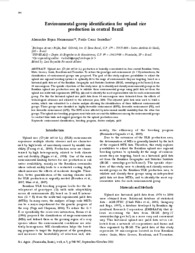Environmental group identification for upland rice production in central Brazil.
Environmental group identification for upland rice production in central Brazil.
Author(s): HEINEMANN, A. B.; SENTELHAS, P. C.
Summary: Upland rice (Oryza sativa L.) production is basically concentrated in four central Brazilian States, Mato Grosso, Goiás, Rondônia and Tocantins. To reduce the genotype and environment (G × E) interactions, the classification of environment groups was proposed. The goal of this study explores possibilities to adjust the upland rice regional breeding systems to optimally fit to the range of environments they are targeting, based on a historical yield data set of the Brazilian Geographic and Statistics Institute (IBGE, http://www.ibge.gov.br/home/) from 54 microregions. The specific objectives of this study were: (i) to identify and classify environmental groups in the Brazilian upland rice production area; (ii) to validate these environmental groups using yield data set from the upland rice multi-trial experiments (MTEs); (iii) and to identify the most representative site for each environmental group. For this the historical upland rice yield data from 54 microregions were detrented from the effects of technological advances and adjusted to the reference year, 2006. The adjusted yield data were used to build a matrix, which was submitted to a cluster analysis allowing the identification of three different environmental groups. These groups were classified as: highly favorable environment (HFE); favorable environment (FE); and less favorable environment (LFE). The HFE is less affected by inter-annual rainfall variability than the other two groups. The upland rice breeding programs must take into account the differences among the environmental groups to conduct their trials and suggest genotypes for the upland production area.
Publication year: 2011
Types of publication: Journal article
Unit: Embrapa Rice & Beans
Observation
Some of Embrapa's publications are published as ePub files. To read them, use or download one of the following free software options to your computer or mobile device. Android: Google Play Books; IOS: iBooks; Windows and Linux: Calibre.
Access other publications
Access the Agricultural Research Database (BDPA) to consult Embrapa's full library collection and records.
Visit Embrapa Bookstore to purchase books and other publications sold by Embrapa.

